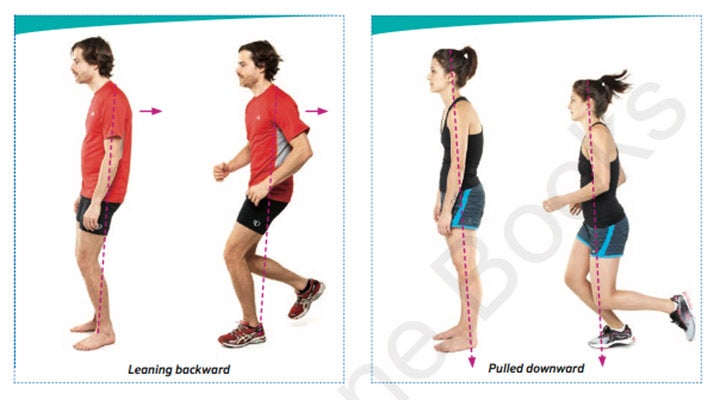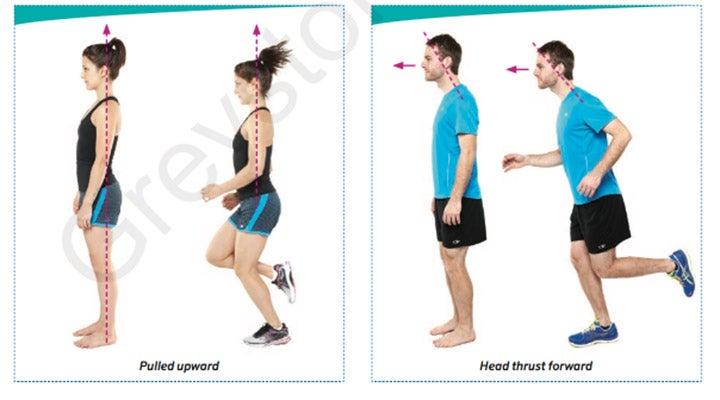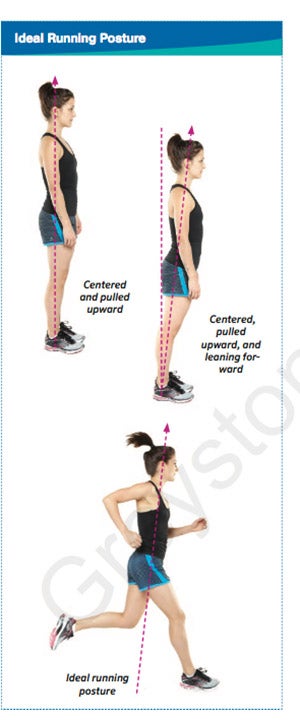New perk! Get after it with local recommendations just for you. Discover nearby events, routes out your door, and hidden gems when you sign up for the Local Running Drop.
To have good posture is to have a body position that is centered spatially and balanced gravitationally.
RUNNING AMPLIFIES IMBALANCES
Most of the time, if we have a postural imbalance, that imbalance will be amplified when running. More rarely, we might try to correct our posture any way we can, resulting in a much greater effort.
RELATED:Dial In Your Trail Running Technique
The good news is that running is actually one of the best ways we can improve our posture. It spurs the body to adjust to a combination of forces, including gravity—without the temptation of a comfy armchair to fall into.


WHY GOOD POSTURE IS IMPORTANT
Posture is the cornerstone of any good running technique. With adequate posture, your muscles, tendons, ligaments, and fascia will be activated correctly. Your Achilles tendon, for example, can only build and release energy effectively if your body is leaning forward. As soon as you lean backward, your Achilles tendon becomes less effective.
To breathe properly
Good posture allows you to breathe properly, and that’s one of the fundamentals of running. In contrast, a hunched body position is an obstacle to proper breathing. Your body can try all it likes to absorb oxygen so it can generate energy, but if your posture is hindering your breathing, you’re wasting lots of energy.
To wake up your feet
There’s been a lot of fuss about our feet being asleep at the wheel when they are supported by modern running shoes. Trying a more minimalist pair of shoes isn’t the only way to wake them up, though. If you maintain good posture, your feet will automatically be more responsive. When you lengthen your spine, you stimulate all of your postural muscles, including your deep foot muscles. This is another example of how the body functions as a whole.
To improve your foot strike
Most running methods are founded on the principle that the first thing you need to do is perfect your foot strike. This is why some runners suffer injuries when they try to achieve a midfoot strike, because the rest of the body is not yet ready for the change.
It is far better to initiate your change in technique by starting with your posture, since everything else depends on it—including foot strike. It is unrealistic to think that everyone can run with a midfoot or forefoot strike without first having good posture.
WHAT IS THE IDEAL RUNNING POSTURE?
The ideal running posture is the one that promotes the most efficient movement and the most natural, flowing running style, while respecting your body as much as possible. Don’t worry if your basic posture looks different from the ideal. You have your own posture, like a body signature. And there’s no reason to change everything overnight. You can gradually work your way toward the ideal without needing to achieve perfection. There is more than just one good running posture, for the simple reason that human beings are not robots.
According to the principles of posturology—the scientific study of posture—and the latest advances in biomechanics, we should be aiming to run tall with a slight forward lean.
WHY RUN TALL?
If you visualize yourself being pulled upward, as if you were growing taller, this will engage your deep postural muscles. These are the muscles that allow your spine to lengthen correctly. In your legs, these muscles counteract gravity by pushing your body away from the ground, making sure it doesn’t collapse when your foot touches the ground. I’m sure you’ll agree this is very useful when it comes to running! In running jargon, this tendency to stretch upward is known as “running tall.” What it really means is running with a long spine, since the spine is the key to this adjustment. Your legs act as springs, supporting a stable pelvis and a long spine.
HOW TO RUN TALL
1. Grow taller as you run
Of course, the most tangible way to run tall is to focus on this aspect of your posture when you’re running. Most people can achieve this lengthening within a short time, and you’ll soon see positive changes in your running technique. The easiest ways for runners to visualize running tall are as followsS
A) String at the crown of the head: Imagine there is a string attached to the crown of your head and it is gently pulling you upward.
B) Head filled with helium: Imagine that your head is lighter than air and is floating skyward.
2. Do exercises to improve your posture
Many people find that their postural muscles are dormant and weak after years of disuse. It is important to reactivate these muscles and take back control of them. Postural exercises can help you to take your running to the next level. What’s more, you’ll see the benefits in the way you hold yourself in everyday life too.
3. Free yourself from the limitations affecting your posture
In some cases, our capacity to stay centered and stand tall is restricted by physical or emotional limitations, such as introversion. This can make it difficult and energy intensive for you to try to keep a straight spine. These are some of the most common physical limitations and how to correct them.
NOW, WHY LEAN FORWARD?
Running is synonymous with forward motion, except in a few special cases (see the sidebar to the right). Now what if you want to move forward effortlessly? Let yourself fall forward, and this will shift your center of gravity in the right direction. Just watch a pack of 100-meter sprinters for the first third of the race, while they’re accelerating toward a constant speed. The faster they accelerate, the more they lean forward. At the start of the race, they lean almost to a forty-five-degree angle before straightening out gradually. And once they’ve reached their cruising speed, they keep leaning forward slightly until they reach the finish line. Endurance runners, who normally run at a constant speed, tend to lean forward by five to twenty degrees.
RELATED: Build A Strong Core For Trail Running
Some methods of running, such as the Pose Method and ChiRunning, emphasize falling forward. Many runners trying to work this idea into their technique take things a step too far, sometimes leaning up to thirty degrees forward of vertical! For most people, inefficiency and injury are just around the corner. I’ve lost count of the number of runners who have come to me for a consult because they’ve developed pain in their Achilles tendon from having modified their technique to fall forward—and excessively so. Some elite runners do manage to maintain an extreme body angle, but this requires a particular biomechanical profile and a great deal of training.
RELATED:Get Stronger On Hills
HOW TO LEAN FROM HEAD TO TOE
Your whole body needs to be slightly leaning forward. Some runners bend at the hips and lean only their head and torso forward. I call this type of runner the Crane (see the illustration on the next page). This posture is inefficient, and it’s too demanding. You should always keep your body centered from head to toe, and lean it forward as a whole from your point of contact with the ground. It is relatively easy to improve your posture if you follow the two principles set out below.

LENGTHEN YOUR SPINE
Start by standing barefoot on a flat surface. Turn your awareness to how your feet are placed. Which surfaces are in contact with the ground? Try to put equal weight on both feet. Then picture a string gradually pulling the crown of your head toward the sky. Your spine will gradually lengthen and you will stand taller, usually by a 1⁄2 inch or so (a centimeter or two). You’ll probably notice that your feet make better contact with the ground too.
LEAN FORWARD
Keeping this more centered and elongated posture, think of your body as an upside-down pendulum. Your feet are in contact with the ground and represent the fixed end of the pendulum. Your head is the other end of the pendulum—the part that is mobile.
Your straight body is free to lean forward and backward. Try this movement a few times. When you lean forward, you should feel like you’re transferring your weight to the front of your feet. And when you lean backward, you should feel your weight shifting to your heels. Finish this little experiment with your body leaning forward and memorize that sensation. When you’re running, you should feel the same thing every time your foot hits the ground.
The key to having good running posture is to allow your body to lean forward, keeping the length in your spine, until you feel that your weight is beneath your toe mounds. When you feel that solid connection, you know your posture is correct. You should feel stable in that position and be able to hold it for a while without too much effort. If not, don’t lean quite so far forward and find a position where you do feel comfortable. If you feel more stable with your weight on your heels, that means you will run more naturally with a heel strike. And if you feel more comfortable with your weight on the front of your feet, you’ll know this is your natural foot strike.
HOW TO FIND A NEUTRAL POSTURE
Finally, seen from the front or from behind, the body’s position should be neither too closed nor too open. Many runners run with a closed stance and an inward focus. More rarely, some runners can be observed exhibiting too much openness, with their front body wide open to the world. Both of these extremes can have an impact on running efficiency. The ideal is to find a neutral posture that’s neither too closed nor too open.
Try scanning your body as you run by asking yourself, Am I too closed or too open in my:
- shoulders?
- chest?
- abdomen?
- pelvis?
- knees?
- feet?
Then adjust each part of your body to a more neutral position as required, remembering to stay as relaxed as possible.